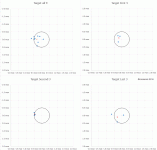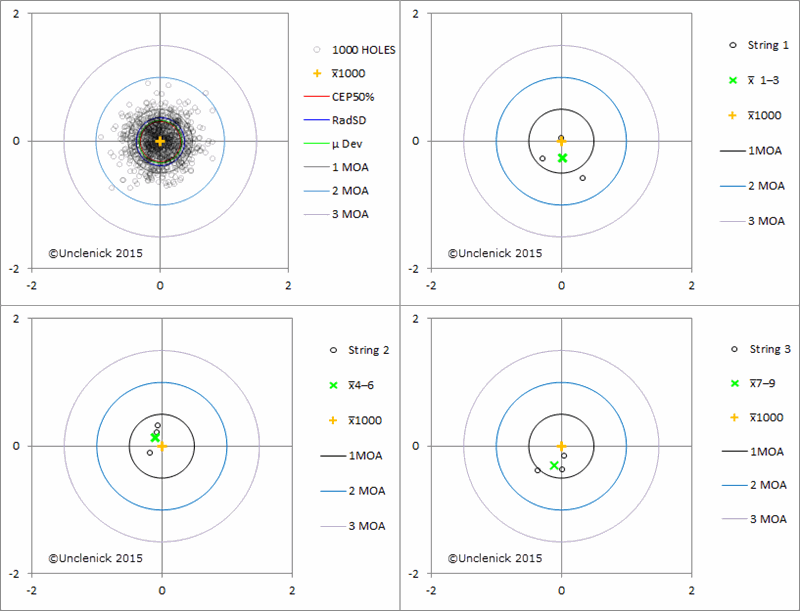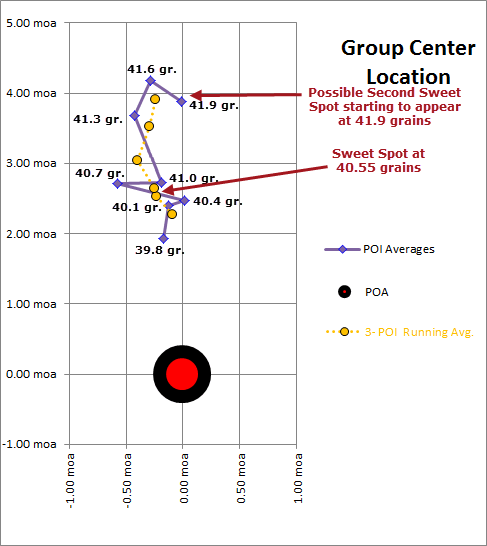I'm working up a load for my 6.5mm Creedmore (Kimber Model 84) and I'm not getting the accuracy I expected. My dilemma rests with the need to seat the bullets such that they fit in the magazine, the available space being no longer than 2.800 inches OAL.
A Berger 130gr VLD at 2.800" OAL puts the bullet 0.098" from the rifling. Using IMR 4350, H4350, Varget, BL-C(2), Hybrid-V 100 and Superformance I cannot get 3 shots less than 1.5 to 3.0 inches center to center, even though 2 shots with Varget were 0.175" (shot #3 was 2.5" away) and Superformance 0.236" (Shot #3 was 1.5" away).
The same pattern exists for a Hornady 140gr SST. At 2.800" OAL it is 0.08" from the rifling.
I have been using loads, 1.0 gr less than maximum, listed in the 50th Edition of the Lyman manual. Another thread suggested H4350 as the standard for this caliber with a load as high as 41.5 to 42.8gr with 140gr bullets, while the Lyman book lists 39.5gr of IMR 4350 as max (velocity 2585fps; 61,000psi) with a 24" barrel. My barrel is 22 inches.
After 40 years of reloading, I'm stuck. Maybe I'm just getting too old to figure it out. Most often my most accurate loads in the 9 different rifle calibers that I have are 0.015 to 0.02" from the rifling.
But this got me to wondering if bullet jump or pressure and velocity are the determinants to accuracy. That would mean I need to leave the seating at 2.800" OAL and simply increase/decrease velocity and pressure. For example, in the Lyman book, the most accurate load with 140gr Hornady A-Max is IMR 4350 at maximum 39.5gr, which gives a velocity of 2585fps and 61,000 psi. But just above it is W760 40.2gr giving a velocity of 2583fps but a pressure of 60,500psi. So much for velocity being the determinant. Another load that gives the same psi of 61,000 and similar velocity (2548fps)should be as accurate as IMR4350 but apparently not. So much for pressure being the determinant. So back to bullet jump I go, I guess. Should I just settle for making this rifle a single shot?
A Berger 130gr VLD at 2.800" OAL puts the bullet 0.098" from the rifling. Using IMR 4350, H4350, Varget, BL-C(2), Hybrid-V 100 and Superformance I cannot get 3 shots less than 1.5 to 3.0 inches center to center, even though 2 shots with Varget were 0.175" (shot #3 was 2.5" away) and Superformance 0.236" (Shot #3 was 1.5" away).
The same pattern exists for a Hornady 140gr SST. At 2.800" OAL it is 0.08" from the rifling.
I have been using loads, 1.0 gr less than maximum, listed in the 50th Edition of the Lyman manual. Another thread suggested H4350 as the standard for this caliber with a load as high as 41.5 to 42.8gr with 140gr bullets, while the Lyman book lists 39.5gr of IMR 4350 as max (velocity 2585fps; 61,000psi) with a 24" barrel. My barrel is 22 inches.
After 40 years of reloading, I'm stuck. Maybe I'm just getting too old to figure it out. Most often my most accurate loads in the 9 different rifle calibers that I have are 0.015 to 0.02" from the rifling.
But this got me to wondering if bullet jump or pressure and velocity are the determinants to accuracy. That would mean I need to leave the seating at 2.800" OAL and simply increase/decrease velocity and pressure. For example, in the Lyman book, the most accurate load with 140gr Hornady A-Max is IMR 4350 at maximum 39.5gr, which gives a velocity of 2585fps and 61,000 psi. But just above it is W760 40.2gr giving a velocity of 2583fps but a pressure of 60,500psi. So much for velocity being the determinant. Another load that gives the same psi of 61,000 and similar velocity (2548fps)should be as accurate as IMR4350 but apparently not. So much for pressure being the determinant. So back to bullet jump I go, I guess. Should I just settle for making this rifle a single shot?



